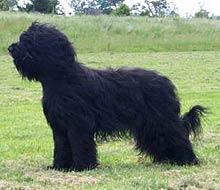 |
|
Grooming
The beautiful shaggy coat must obviously be cared for, but it's not as time consuming as you might think. You need to allow an hour or two once a week but if you miss a week it will take longer the following week. Briards don't have a thick undercoat and the top coat is almost straight and fairly coarse, so they are easier and quicker to groom than many other long coated breeds. Briards don't have an annual moult so regular grooming minimises the amount of hair shed around the house. No trimming is required for a Briard. A good quality boar bristle brush, a pin brush, and a steel tooth comb are the basic implements needed to keep your Briard looking its best. Electric combs are also a useful addition to the grooming box.
Training
Briards learn most things quickly and easily provided you set limits and stick to them consistently. But as with any breed they will pick up bad habits just as easily if allowed.
Although Briards can and have been trained for competitive obedience and agility, on occasion their innovative streak can produce interesting variations to standard exercises! They will NEVER become ring robots.
It is strongly recommended that you take your Briard to obedience school.
They still retain very strong herding instincts and can successfully be trained to work sheep. (If there are no sheep available, they will herd duck, chickens, children - or anything else that comes to hand!) Herding is taken very seriously in the USA and there are many Briards that compete at the highest levels. In France, many farms still use the Briard as the primary herding dog.
Leisure Pursuits
Briards are happiest to be sharing your company whatever you are doing. They will love long walks where they can explore ahead but continually return to 'check in' with their owners. As a bonus they can reliably be taught to come when they are called. They also enjoy being around water and most are tennis balls fanatics!!
Longevity
Briards can be expected to live to 12-13 years of age with a significant number living to 14 and some until they are 15. With very few exceptions they remain active and healthy with few signs of ageing until a sudden final illness overtakes them.
Undesirable traits to be warned about
Because Briards have been bred for centuries as watch-dogs on remote French farms, by nature they tend to be reserved with strangers. (Though once they have accepted and made friends with someone they will never forget.) To counteract this natural aloofness, Briard puppies must have plenty of 'socialising' while they are young. This will in no way lessen their effectiveness as guard-dogs.
Puppy pre-school classes are an excellent way of starting the socialising process. Many vet clinics now hold weekly classes as do some obedience schools.
A young Briard's exuberant display of affection (while welcomed by most owners) may seem overwhelming to some people who may be happier owning a quieter, less demonstrative breed.
Size: 58 -68 cms |